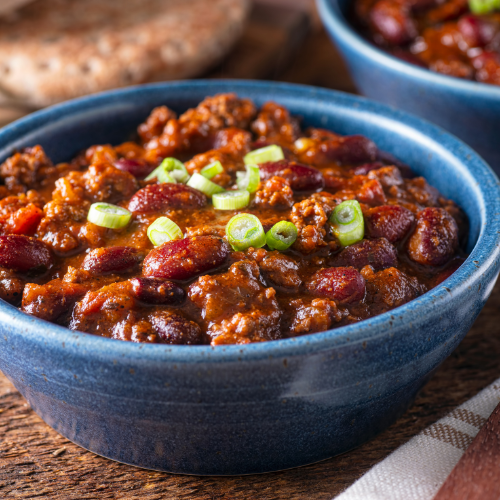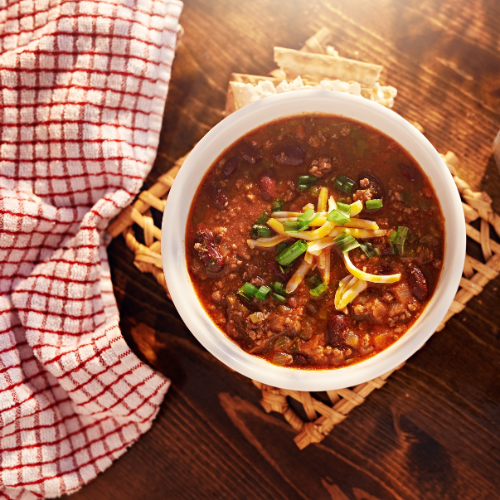Classic Chili recipe
Introduction
Chili, a hearty and flavorsome stew, has long captured the hearts and palates of people around the world. With its roots tracing back to indigenous cuisines in the Americas, chili has evolved into a beloved dish that has made its mark on countless dining tables. This article delves into the enticing realm of classic chili recipes, exploring their origins, popularity, and significance in American cuisine.
A Fiery Heritage: A Brief History of Chili
The history of chili can be traced back several centuries to the indigenous peoples of the Americas. Native tribes such as the Aztecs and Incas were known for incorporating various types of peppers and spices into their meals.
However, it was not until the arrival of Spanish colonizers that these spicy stews began to resemble what we now consider chili. As Spaniards explored new lands, they brought with them ingredients like cumin and garlic to enhance their culinary creations.
The addition of these aromatic spices transformed indigenous dishes into complex stews seasoned with an irresistible blend of flavors. Over time, traditional Mexican dishes like "chili con carne" gained popularity among settlers in regions such as Texas.
The Everlasting Appeal: Popularity of Classic Chili
Today, chili holds a cherished place in American cuisine and continues to win over hearts with its irresistible taste and comforting qualities. Its enduring popularity can be attributed to both its versatility as a dish and its ability to bring people together.
Whether served at casual backyard gatherings or enjoyed as an essential part of game day feasts during football season, classic chili is always warmly welcomed. The allure lies not only in its rich flavor but also in its adaptability to suit various tastes and dietary preferences.
From meat lovers relishing hearty beef-based chilis to vegetarians savoring vegetable-packed alternatives, there is a chili recipe to satisfy every palate. The simplicity of the dish also contributes to its popularity, as it can be cooked on stovetops, in slow cookers, or even over open fires during camping trips.
Moreover, chili has become an emblematic representation of American culture and a symbol of rugged individualism. It embodies the spirit of exploration and innovation, as countless cooks experiment with different combinations of ingredients and spices to create their signature chili recipes.
This adaptability has led to regional variations across the United States, each with its own unique twist on this beloved classic. As we venture deeper into the world of classic chili recipes in this article, we uncover the secrets that make this humble stew a timeless staple—an embodiment of comfort and culinary craftsmanship.
The Basics of Classic Chili
Definition and Characteristics of Classic Chili
Classic chili is a hearty and flavorful dish that originated in the United States. It is known for its robust combination of ingredients and warm, comforting flavors.
At its core, classic chili is a thick stew-like preparation primarily made with ground beef, onions, garlic, tomatoes, beans, and spices. The defining characteristic of classic chili is its balance between heat from spices like chili powder and cayenne pepper and the natural sweetness of tomatoes.
What sets classic chili apart from other types of stews or soups is its specific consistency - it should have a thick broth that coats the ingredients without being overly watery. The texture should be rich and meaty, with each spoonful offering a complexity of flavors that blend harmoniously together.
Key Ingredients: Ground Beef, Onions, Garlic, Tomatoes, Beans, and Spices
The foundation of classic chili begins with high-quality ground beef. This meat imparts richness to the dish while also providing texture.
Lean ground beef works well for those seeking a healthier option but using a combination of lean and fattier cuts can add depth to the overall flavor. Onions are an essential component as they add sweetness and depth to the base of the chili.
They are typically sautéed until translucent before incorporating other ingredients to build layers of flavor. Garlic adds aromatic notes when minced or crushed into the mixture.
It brings out earthy undertones that complement the spices used in traditional recipes. Tomatoes contribute acidity to balance out the richness from meat and beans while adding their distinctive tanginess.
Canned diced tomatoes or fresh tomatoes can be used depending on personal preference. Beans are another crucial element in classic chili recipes.
While there are debates about whether beans belong in authentic Texas-style chili (which traditionally omits them), most classic chili recipes include them. Common options include kidney beans, black beans, or pinto beans, which add a creamy texture and additional protein.
The spices used in classic chili play a vital role in creating the signature flavor profile. Chili powder is the star ingredient that gives the dish its distinct heat and smokiness.
Other common spices include cumin, paprika, oregano, and cayenne pepper. These spices add layers of complexity and warmth to the overall taste experience.
Variations Across Different Regions in the United States
As classic chili has evolved over time and spread across different regions of the United States, variations have emerged to reflect local tastes and cultural influences. In Texas, for instance, traditional chili recipes often exclude beans entirely but rely heavily on quality beef cuts combined with bold spices for a robust flavor profile. In other parts of the country like Cincinnati, Ohio, "Cincinnati-style" chili incorporates unique elements such as cinnamon or cocoa powder to create a distinctive sweet-spicy profile.
This variant is often served over spaghetti noodles or on top of hot dogs with an assortment of toppings. The southwestern region embraces flavors inspired by Mexican cuisine by adding ingredients like green chilies or chipotle peppers for added heat and smokiness.
Some regional variations also introduce ingredients like corn or bell peppers to enhance textural contrast and sweetness within each spoonful. It's worth noting that while regional differences exist, classic chili remains beloved nationwide as a delightful comfort food that brings people together around hearty bowls filled with warmth and flavor.
The Art of Preparing Classic Chili
Choosing the right cut of beef and grinding it at home for optimal flavor
The key to a truly exceptional classic chili lies in selecting the appropriate cut of beef and grinding it at home. This ensures maximum freshness and flavor in every bite.
For the best results, opt for a lean cut of beef such as chuck roast or sirloin steak. These cuts contain enough marbling to impart richness and tenderness to the chili without being overly fatty.
To grind the beef at home, start by cutting it into small cubes, around 1-inch in size. This will make it easier to grind evenly.
It is recommended to use a meat grinder attachment for your stand mixer or a dedicated meat grinder if available, as this allows you to control the coarseness of the ground meat. A medium grind works well for classic chili as it provides texture while allowing the flavors to meld together harmoniously.
Sautéing onions and garlic to build a flavorful base
Creating a robust base is crucial in developing layers of flavor in your classic chili recipe. Begin by finely chopping fresh onions and mincing garlic cloves. In a large Dutch oven or heavy-bottomed pot, heat some oil over medium-high heat until shimmering.
Add the onions and garlic to the pot and cook them until they become translucent and fragrant, stirring occasionally to prevent burning. This process not only softens their texture but also releases their natural sweetness and aroma, which will deeply enhance the overall taste profile of your chili.
Sautéing onions and garlic acts as an essential foundation that sets off all other ingredients beautifully, allowing them to blend seamlessly together when combined later on. Take your time with this step; it's worth investing those extra minutes for an unparalleled depth of flavor.
Incorporating various spices like chili powder, cumin, paprika, oregano, and cayenne pepper for depth of flavor
The distinctive flavor of classic chili is brought to life through a harmonious blend of spices. Chili powder serves as the backbone of the seasoning, infusing the dish with its characteristic warmth and earthiness.
Cumin adds a nutty undertone while paprika contributes a mild smokiness that complements the other flavors beautifully. To achieve a well-balanced blend of spices, it's important to measure each one carefully.
Start with a tablespoon of chili powder as the base and then add half a teaspoon each of ground cumin, paprika, dried oregano, and cayenne pepper for an extra kick if desired. Adjust these amounts according to your personal taste preference.
By introducing these spices into your classic chili recipe, you create a symphony of flavors that work together harmoniously to awaken your taste buds. Each spice plays its own role in enhancing the richness and depth present in every spoonful.
Balancing flavors with a touch of sweetness from brown sugar or molasses
Achieving perfect balance is essential to creating an exceptional classic chili recipe. Alongside the savory and spicy elements, incorporating just a touch of sweetness can elevate the overall flavor profile by rounding out any sharp edges. To achieve this balance, consider adding some brown sugar or molasses during cooking.
Start with about one tablespoon per pound of ground beef and adjust according to personal preference. The sweet notes from these ingredients help mellow out any lingering bitterness while adding complexity and depth to your chili.
However, it's important not to overdo it; you want just enough sweetness to complement the other flavors without overpowering them. Taste as you go along and adjust accordingly until you find that perfect harmony between savory spice and subtle sweetness in your classic chili creation.
Enhancing the Flavor Profile: Experimenting with Different Types of Beans for Texture and Taste Variation
When it comes to classic chili, the choice of beans can significantly impact its texture and flavor. While kidney beans are the most common variety used in traditional recipes, there is no shortage of options to explore.
Black beans, with their rich and earthy flavor, can provide a delightful contrast to the savory notes of the chili. They also have a slightly firmer texture, adding an enjoyable bite to each spoonful.
On the other hand, pinto beans offer a creamier consistency and a mild, nutty taste that complements the overall flavor profile. To enhance your chili's complexity further, consider mixing different types of beans together.
Combining kidney beans with black or pinto beans not only adds visual appeal but also introduces an enticing medley of textures and flavors. Experimentation is key in finding your preferred bean combination; it allows you to create a unique chili experience tailored to your taste preferences. Adding Diced Bell Peppers or Jalapeños for a Hint of Heat and Crunchiness
For those who appreciate a bit of heat in their chili, diced bell peppers or jalapeños can be excellent additions. Bell peppers come in various colors – red, green, yellow – each imparting its distinct sweetness and crunchiness to the dish. When sautéed with onions and garlic at the beginning stages of cooking, they release subtle flavors that blend harmoniously with other ingredients.
If you're looking for more fiery intensity in your chili recipe, jalapeños are sure to deliver. These small green chilies pack a punch but offer vibrant freshness and fruity undertones amidst their spiciness.
By removing their seeds (which contain most of their heat), finely dicing jalapeños allows you to control the heat level while preserving their unique flavor profile. Whether you opt for mild or intense, the addition of bell peppers or jalapeños introduces exciting layers of taste and texture to your classic chili, making it even more enjoyable for both heat seekers and milder palates alike. Incorporating Beer or Coffee to Intensify the Richness and Complexity
To take your classic chili recipe from delicious to extraordinary, consider incorporating unexpected ingredients like beer or coffee. Both these additions can elevate the flavor profile, creating a depth tantalizing the taste buds.
Beer not only adds a distinctive hoppy note but also imparts an earthy richness that complements the hearty flavors of meat and spices. The carbonation in beer helps tenderize the meat while simmering, resulting in a melt-in-your-mouth texture.
Opt for a dark, malty beer like stout or porter for a robust flavor infusion. On the other hand, coffee brings a unique edge to chili by providing bitterness that balances out sweetness and acidity.
The rich aroma and depth of brewed coffee intensify the overall complexity of flavors in your chili. Choose a medium to dark roast coffee for its strong character without overpowering other ingredients.
By experimenting with different types of beans, adding diced bell peppers or jalapeños for heat and crunchiness, as well as incorporating beer or coffee for richness and complexity, you can truly enhance your classic chili recipe. These additions will transform your dish into a culinary masterpiece that delights every sense – from its vibrant colors to its enticing aroma and remarkable taste experience.
Secret Ingredients that Make a Difference
A. Unsweetened chocolate: Enhancing Depth and RichnessWhen it comes to creating a truly exceptional classic chili, one secret ingredient that might come as a surprise is unsweetened chocolate. Just a small amount of this magical ingredient can work wonders in elevating the depth and richness of your chili without imparting any overt chocolaty flavor. The addition of unsweetened chocolate adds a subtle complexity to the dish, providing a velvety smoothness and enhancing the overall flavor profile. Unsweetened chocolate contains cocoa solids without any added sugar or milk, which makes it perfect for savory dishes like chili. The intense bitterness of the chocolate beautifully complements the earthy flavors of the tomatoes, spices, and meat in the chili. It helps to balance out any excess sweetness from other ingredients while adding an intriguing layer of depth. To incorporate unsweetened chocolate into your classic chili recipe, simply chop it finely or grate it using a cheese grater before adding it to your simmering pot. Allow it to melt slowly into the mixture, stirring gently until fully incorporated. Be careful not to use sweetened or semi-sweet chocolates as they can alter the intended flavor profile.
B. Worcestershire Sauce: Elevating Flavor with UmamiAnother indispensable secret ingredient that can take your classic chili recipe to new heights is Worcestershire sauce. This fermented condiment has been used for centuries for its distinctive umami kick and ability to enhance flavors in various dishes. Worcestershire sauce adds a unique depth and complexity by infusing umami-rich notes into your chili's taste profile. Made from fermented fish (such as anchovies), vinegar, molasses, garlic, tamarind extract, onions, and various spices like cloves and cinnamon, this sauce provides an irresistible savory tang that complements the well-rounded flavors of classic chili. To incorporate Worcestershire sauce into your chili, simply add a generous splash during the cooking process. It will meld beautifully with the other ingredients, enriching both the aroma and taste. The sauce is usually added towards the end of cooking to ensure its flavors remain present and distinct. Adjust the amount according to your personal preference, keeping in mind that it is a key ingredient for enhancing umami.
C. Liquid Smoke: Embracing Smoky UndertonesFor those who relish smoky undertones in their chili, liquid smoke is an excellent secret ingredient to consider. This potent seasoning offers a quick and convenient way to infuse your chili with a distinct smokiness reminiscent of slow-cooked barbecue or open fire grills. Liquid smoke is derived from capturing the vapors produced during burning wood, typically hickory or mesquite. It provides an intense smoky flavor without requiring hours of smoking meat over charcoal or wood chips. By adding just a small amount of this concentrated liquid, you can achieve that desirable smoky essence without overwhelming other flavors in your classic chili. To use liquid smoke effectively, add it sparingly at first and adjust according to your preference for strength and intensity. Remember that its flavor can be quite potent, so start with a few drops and gradually increase if desired. Allow the chili to simmer for some time after adding liquid smoke to let its distinctive aroma permeate throughout. By incorporating these secret ingredients – unsweetened chocolate, Worcestershire sauce, and liquid smoke – into your classic chili recipe, you can take it from good to exceptional. Each of these additions brings its own unique contribution: enhancing depth with chocolate's richness, elevating overall flavor with Worcestershire sauce's umami kick, or embracing smoky undertones through liquid smoke's concentrated essence. Experimentation with these ingredients will enable you to create a chili that tantalizes the taste buds and delights your fellow chili enthusiasts.
Serving Suggestions
Traditional Accompaniments: A Symphony of Flavors
When it comes to serving classic chili, the options for accompaniments are truly endless. Traditional toppings that perfectly complement the robust flavors of chili include shredded cheese, sour cream, diced onions, jalapeños, cilantro, and lime wedges.
These ingredients add layers of texture, freshness, and tanginess to the dish. Shredded cheese is a popular choice for adding richness and creaminess to each spoonful of chili.
Cheddar or Monterey Jack cheese work well in this role, as they melt beautifully over the hot chili and offer a delightful contrast to its spiciness. A dollop of cool sour cream not only adds a creamy element but also helps balance out any heat if you prefer a milder version.
For those seeking an extra kick of flavor and crunchiness, diced onions and jalapeños are fantastic additions. The sharpness and slight pungency of onions bring complexity to every bite while jalapeños contribute both heat and a crisp texture that contrasts with the tender beans and meat in the chili.
Garnishing with fresh cilantro leaves adds an herbaceous note that brightens up the overall flavor profile. Squeezing a splash of lime juice over your bowl imparts a tangy zest that ties all these elements together harmoniously.
Conclusion
Classic chili is not merely a hearty one-pot dish; it represents an emblematic slice of American culinary heritage that has stood the test of time. Its versatility allows for personalization according to regional preferences or individual palates.
Whether you enjoy it mild or fiery hot, with or without beans – classic chili remains an evergreen favorite. Preparing your own classic chili affords you not only the pleasure of aroma-filled kitchens but also endless possibilities for creativity in choosing ingredients and spices.
The communal act of gathering around a steaming pot of chili, adorned with a symphony of toppings, brings people together and fosters a sense of warmth and comfort. So, next time you embark on your chili-making journey, remember to savor the process, embrace experimentation, and most importantly, share the joy of this timeless dish with loved ones.
Classic Chili Recipe
Ingredients:
2 lbs ground beef
2 onions, diced
4 cloves garlic, minced
2 15-oz cans red kidney beans, drained and rinsed
2 15-oz cans diced tomatoes
3 tablespoons chili powder
2 teaspoons cumin
1 teaspoon oregano
1 teaspoon salt
1/2 teaspoon black pepper
2 cups beef broth
Optional toppings: shredded cheddar cheese, sour cream, chopped green onions
Instructions:
In a large pot or Dutch oven, cook the ground beef over medium heat until browned. Drain excess grease and set the meat aside.
In the same pot, add the diced onions and cook until they become translucent, about 5 minutes. Add the minced garlic and cook for another minute.
Return the cooked beef to the pot. Stir in the chili powder, cumin, oregano, salt, and pepper. Cook for about 2 minutes to allow the spices to blend with the beef and onions.
Add the kidney beans, diced tomatoes (with their juice), and beef broth to the pot. Stir well to combine all the ingredients.
Bring the mixture to a boil, then reduce the heat to low, cover the pot, and let it simmer for about 1-2 hours. This will allow all the flavors to meld together and will make the chili rich and thick.
Serve hot, garnished with your choice of toppings such as shredded cheese, sour cream, and chopped green onions.
Note: Chili tastes even better the next day, as the flavors continue to meld together. So feel free to make it a day in advance for maximum flavor.
Conclusion
A classic chili recipe is a staple in American cuisine and a comforting dish loved by many. Its unique blend of ingredients, bold flavors, and historical roots make it a timeless and versatile dish that can be adapted to suit any palate. Whether you're a fan of spicy, mild, meat-based, or vegetarian chili, there's a version for everyone to enjoy. So why not try making a pot of classic chili for your next gathering? You won't be disappointed.













